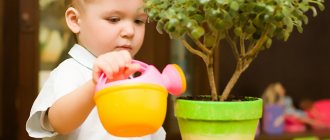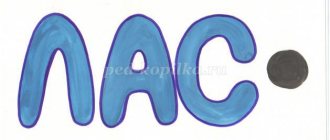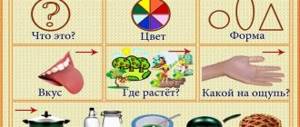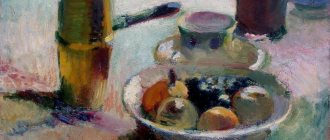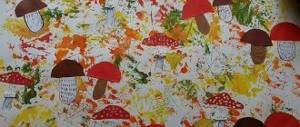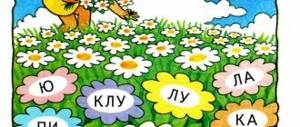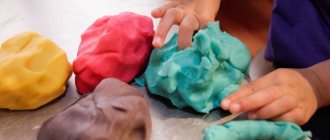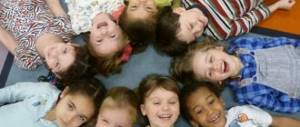Lesson 5. Lexical games and exercises
⇐ PreviousPage 7 of 18Next ⇒
Target. Activate children's speech, improve phonemic perception of speech.
Progress of the lesson
“I have already told you many times that you should listen carefully to the words that I pronounce,” the teacher begins the conversation. – If you mumble just one sound in a word, it turns out to be nonsense. Shall we check?
Rooks are hurrying, doctors are flying. Which letter changed the word rooks
?
(Letter V.)
There were barrels, behind the barrels there were daughters.”
The teacher pronounces the following pairs of words: house - catfish, beetle - onion, poppy - varnish
.
Next, the teacher invites the children to listen to the story and fantasize: “In one fairy-tale town, the names of animals were written on all the houses: Squirrel, Hedgehog, Raccoon... One day a new beautiful house was built in the city, on which the inscription soon appeared: “Cat.”
The little mice ran to school. They saw the sign and read: “Cat.” Can you imagine their behavior, convey their conversations? (For example: “What a horror! Now we will have to go to school by a different route. The house is very rich. This cat must have a servant,” etc.)
The cat was running errands. Can you describe it? And what did the kitty meow when she saw the inscription “Cat”?
The dog ran behind. What breed do you think she was? Seeing the “Cat” sign, the dog got angry...
And the little girl who was walking next door couldn’t read. But she saw a cat come out of the house and sit on the porch step. The girl immediately appeared next to him and spoke to him. What do you think about?”
In conclusion, you can read to the children an excerpt from N. Matveeva’s poem “Confusion”:
One, two, three, four, five, I begin to repeat: A Bud is baked in the oven, And a Loaf is inserted into the buttonhole, A Can crawls through the grass, Milk flows into Concrete, And there is a Python at a construction site...
The teacher repeats the poem, and the children finish the words bud, loaf, can, concrete, python
.
Lesson 6. Reading K. Paustovsky’s fairy tale “Warm Bread”
Target. Introduce children to the literary fairy tale “Warm Bread” by K. Paustovsky.
Preliminary work. The day before, read the work of K. Paustovsky “The Thief Cat” to the children.
Progress of the lesson
The teacher asks the children if they remember the name of the author of the story “The Thief Cat.”
When the children name the author, he continues: “Readers (Who are they?) call Paustovsky a singer of Russian nature. Indeed it is. The writer describes corners of nature and natural phenomena so vividly and memorablely that these descriptions remain in the memory for a long time. And he knows how to make you laugh. After all, you laughed when I read about the tricks (actions) of the red cat. And Konstantin Paustovsky also knows how to put the reader in a very serious mood. See for yourself by listening to his new work, called “Warm Bread”. This is a very wise fairy tale. If you understand its meaning, understand what rudeness and cruelty leads to, you will become kinder.”
The teacher reads a fairy tale. Then he asks the children: “What did this fairy tale teach you?”
Lesson 7. Underwater world
Target. Improve children's dialogical speech and ability to write stories on a given topic.
Preliminary work. Together with the children, the teacher looks at pictures depicting animals of the seas and oceans[10]. Then he asks the children where and what marine inhabitants they saw and what they know about their habits.
READING THE BOOK “CLASSES ON SPEECH DEVELOPMENT IN A KINDERGARTEN GROUP PREPARATORY FOR SCHOOL. LESSON PLANS" (PAGE 7)
Progress of the lesson
The teacher invites the children to create their own underwater world on sheets of paper (the images should be conventional so that the children can “read” what they depict). One child, using pictures, creates his own version of the underwater world at the board. Then he talks about what he managed to see in the depths of the sea. The children ask him clarifying questions.
The teacher notes the successful beginning of the story or, conversely, suggests how the story would benefit if the child started it something like this... (sample).
The teacher calls the second child. While he works, 3-4 children talk about their paintings.
If there is time left, you can offer children tasks for ingenuity (exercise “What’s extra?”):
– cod, herring, spinning rod, perch;
– gudgeon, pike, roach, crab.
Lesson 8. First snow. Memorizing A. Fet's poem “Mom! Look out the window..."
Target. Develop children's ability to perceive poetic speech. Help me remember A. Fet’s poem “Mom! Look from the window...”
Progress of the lesson
“Did any of you manage to see the first snow? – the teacher asks the children. “Are you happy about this or sad?”
The teacher says that there are many good poems that are called “First Snow”, and reads a poem by I. Bunin:
The winter cold smelled on the fields and forests. The skies lit up with bright purple before sunset.
At night the storm raged, And with dawn the first snow fell on the village, on the ponds, on the deserted garden.
And today, over the wide White tablecloth of the fields, We said goodbye to the belated Swirl of geese.
The teacher asks the children which lines they remember and repeats them.
Then he reads Y. Akim’s poem “First Snow”:
In the morning the cat brought the first snow on its paws! First snow!
It has the Taste and smell of the first snow! First snow!
He is spinning, Light, New, Above the guys' heads, He managed to spread a down scarf on the pavement,
He turns white along the fence, takes a nap on the lantern,—
This means, Soon, Very soon, the Sleigh will fly down the hills. This means it will be possible to Build a Fortress in the Yard Again!
Children usually ask the teacher to repeat the lines about how the snow spread a downy scarf and lay down (snuzzled) on the lantern.
“But what I like most is Afanasy Fet’s poem “Mom!” Look from the window,” says the teacher and reads the poem (abbreviated).
The teacher invites the children to memorize the poem.
Then he asks the children: “What do you think, what does a cat washing its nose (muzzle) and the first snow have to do with it? There is a sign: if a cat diligently (how is that?) washes its face, there will be guests. Why isn’t snow a guest?”
The teacher repeats the first six lines of the poem:
Mother! Look from the window - You know, yesterday it was not for nothing that the cat washed her nose! There is no dirt, the whole yard is covered, It has brightened, turned white - Apparently, there is frost.
“The first lines of the poem - a child’s address to his mother,” says the teacher, “can be read in different ways. Let's try (3-4 answers).
What made the child looking out the window so happy? He saw that there was no dirt... (3-4 children read these lines).”
The teacher repeats the passage and adds the following six lines to it:
Now there will be no argument: It’s fun to run on the sled, and it’s fun to run up the hill! Really, mom? You won’t refuse, but you yourself will probably say: “Well, hurry up and go for a walk!”
The teacher asks 3-4 children to repeat three lines of the poem that convey the joy of the child looking forward to skiing down the mountain. The teacher evaluates the recitation.
“But the last lines,” says the teacher, “I would probably read differently than the previous ones, with pleading notes and a little quieter.” Children read these lines together with the teacher, and then 3-4 children individually.
The teacher repeats the poem, children can read along with him, but without a voice. Later, he reads the poem outside of class and asks the children to repeat it.
December
⇐ Previous7Next ⇒
Recommended pages:
Use the site search:
Lesson 1. Lexico-grammatical exercises
Target. Activate children's speech.
Progress of the lesson
The teacher asks the children what time of year it is and what month replaced September.
“Autumn, autumn,” says the teacher. “And what can we say about autumn - autumn - autumn?”
The teacher evaluates the children’s answers, praises them for their ability to listen to the task and gives their options: autumn bad weather, autumn slush, autumn leaf, autumn mood, etc.
“In the fall, both people and animals make provisions for the winter,” the teacher reminds.
The hedgehog went out for a walk and picked mushrooms.
What kind of mushrooms do you think he came across?
Many words have related words, for example: hedgehog - hedgehog... ( ezhikha - ezhata - hedgehog - hedgehog)
».
Then the teacher invites the children to complete the exercise “One - many”: “There is one heron, but there are many ... (herons)
, one pack of sugar, but many...
(packs)
, one sock, but many...
(socks)
, one stocking, but many...
(stockings)
, one ear, but many...
(ears)
.
“Now help me finish the sentences,” the teacher asks:
– If we pay attention during speech development classes, then...
- To study well, you need...
– We grow up healthy and strong because...
“When we return from our walk, then...”
After listening to the children’s answers, the teacher repeats the complete sentence.
The teacher invites the children to listen to the poem:
I tried various drinks, I drank golden juices by the full cup. They are - I do not belittle - excellent, but they pale in comparison with yogurt. A. Smirnov
“What drinks do you prefer? - asks the teacher. – Prefers – this means... (chooses from many others, loves)
».
Lesson 2. Memorizing A. Fet’s poem “The Swallows Are Missing...”
Target. Help children remember A. Fet’s poem “The Swallows Are Missing...”.
Progress of the lesson
“We live in Russia, a country with a huge territory. I flew from Moscow to Khabarovsk all day. If I had traveled by train, I would have spent seven to eight days on the road, that is, a whole week. And the climatic conditions in different regions of the country are different. Somewhere in the south it is still hot, and in the north there is already snow. And we have?
Each territory has its own autumn signs. But there are also common ones. Sooner or later, they will announce themselves. As in this beautiful poem by the wonderful Russian poet Afanasy Fet:
The swallows disappeared, And yesterday the dawn All the rooks flew Yes, like a net, they flashed over that mountain.
In the evening everyone sleeps, It’s dark outside. A dry leaf falls, At night the wind gets angry and knocks on the window...
A beautiful poem? Sonorous, elegant."
The teacher repeats the poem, after asking the children to remember the signs of autumn.
Then the children take turns naming the signs, and the teacher reads the corresponding lines of the poem. At the same time, he clarifies: “Are the swallows gone? Where did they hide? And the rooks flew and flashed like a net when?” (In the evening, at dawn.)
The teacher draws attention to the unusual comparison of a flying flock of birds with a net. Then the teacher reads the poem again, inviting the children to repeat it with him, but without a voice. Shows how it's done. (This technique is an effective means of training the articular apparatus.)
The teacher expresses confidence that this poem, if read to your family, will make them very happy.
“By the way, who are your relatives?” – the teacher clarifies and asks to name the words-relatives: “Kin - relatives ... (parents, born, pedigree, maternity hospital)
».
Lesson 3. Sound culture of speech. Preparing for literacy
Target. Improve children's auditory attention and perception. Learn to determine the number and order of words in a sentence.
Progress of the lesson
The teacher asks the children what kind of objects are in front of them and why they are needed in a lesson on speech development (cards from math sets, small objects, sheets of paper, pencils).
The teacher monitors the correct use of complex sentences by children.
Then he invites the children to clap their hands if they hear the sound ts
:
heron, crane, scratched, wounded, blossomed, withered, singer, dancer, ballerina, kiss
.[5]
The teacher takes note of children who make mistakes or respond to a word late, focusing on the response of their peers. Additional work needs to be done with these preschoolers later. But this can also be done in class, inviting only these children to complete a new task (explaining the reason): princess, too much, stubborn, girl, but written, beauty
.
The teacher asks the children to listen very carefully to the lines from G. Lagdzyn’s poem “Tell”, to count the words in the text with the growling sound p
and show a card with the appropriate number of geometric shapes (circles, triangles). The teacher reminds the children that they need to work independently.
Where are you going, magpie? Tell! Show us the way to the dense forest!
The teacher asks the children a riddle:
The golden apple rolls across the sky, smiling in the morning. And smiles are rays, very hot. (Sun)
The teacher asks preschoolers to determine how many words with the sound h are in the text of the riddle .
Then he reads the riddle again, pronouncing the words slowly and clearly, and the children count the words with the sound
h
.
The teacher asks the children to draw grids of three cell windows and determine the location of the sound h
in words:
cup, eyeglass case, hoop
.
Children, using chips or small objects, mark the position of the sound h
in words. (After completing each task, the child removes the chip(s).)
"The word cup
starts at
cha-
,” the teacher continues the lesson.
– How many sounds do you hear? Name these two sounds. Two sounds are already a syllable, that is, part of a word. Try to remember words that begin with the syllable cha-.
(Tea, kettle, watch, cups.) There are quite a lot of such words.”
The teacher opens the dictionary and reads words starting with the syllable cha-,
for example:
seagull, sorcerer, czardash, cha-cha-cha, ditty, palisade
. Interested in what czardash, cha-cha-cha, palisade is?
Then the teacher asks the children what a sentence is. (These are several words connected to each other.)
“The wonderful Russian poet Alexei Pleshcheev has a poem “Granddaughter”. It begins like this: “Grandma, you were little too...” Can you count the words in this sentence? Does it have four or five words? Let's count. Grandmother
- one,
you
- two... Now say the words in strict sequence one after another.”
The teacher points to the child. He says the word, and all the children say his number.
Child. Grandmother.
Children. Once. (One.)
Child. You.
Children. Two.
And so on.
If someone was in a hurry and missed a word, everything starts all over again.
The teacher tells the children that in books there is a period at the end of the sentence: “When you look at the books, pay attention to the periods. You will see that there are long and very long sentences, and there are short and very short sentences. If you find something interesting, share your observations with me.”
At the end of the lesson, the teacher asks the children what they learned today. (We learned to hear words, explain their meaning, and prepared for school.)
If you have time, you can read A. Pleshcheev’s poem “Granddaughter” to the children (this poem can also be read during a walk or before going for a walk).
Grandma, were you little too? And loved to run, and picked flowers? And you played with dolls, grandma, right? What hair color did you have then? So, I will also be a Grandmother, - Isn’t it possible to remain Little? I love my grandmother – my mother’s mother – very much. She has a lot of wrinkles, And there is a gray strand on her forehead, You just want to touch her, And then kiss her. Maybe I too will be old and gray-haired, I will have grandchildren, And then, putting on glasses, I will tie gloves for one, and shoes for the other.
